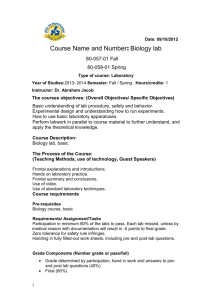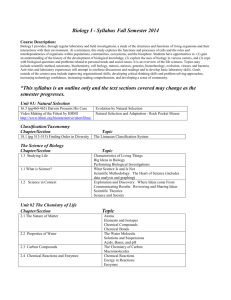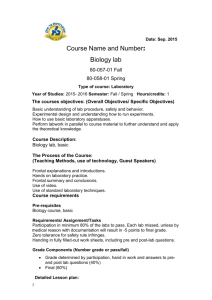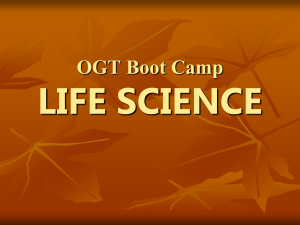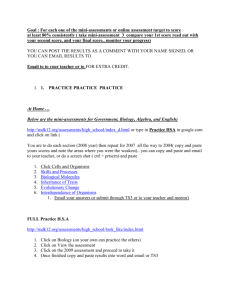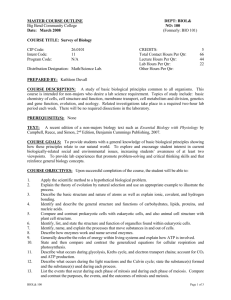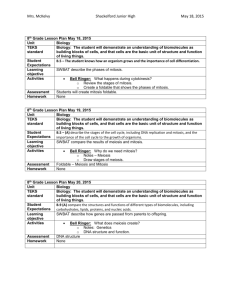Biology Lesson Study ppt
advertisement
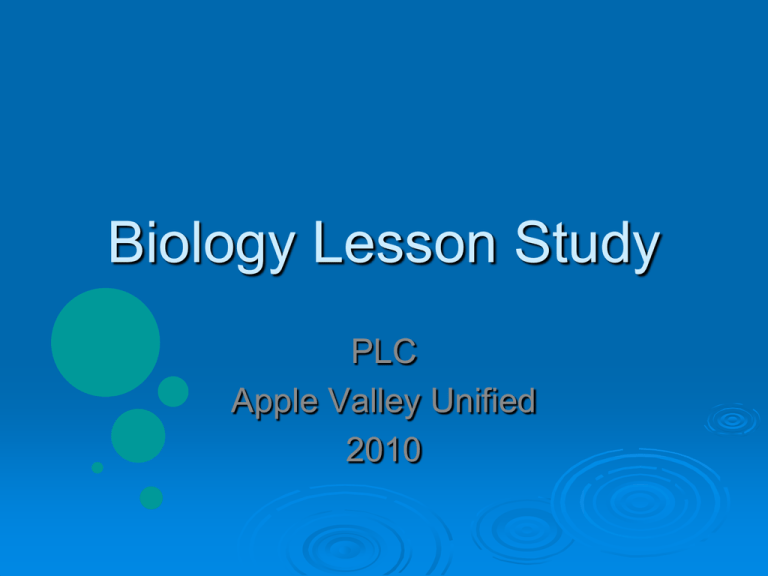
Biology Lesson Study PLC Apple Valley Unified 2010 Where did this idea come from? Attended a workshop at the CSTA last year presented by the K-12 Alliance -Kathy Di-Ranna Visible Learning – by John Hattie The teacher and how they teach is the most important factor Read lots of articles about Lesson Study Visible Learning By John Hattie “Teachers who are passionate about making a difference are more likely to make a difference. There is quite a contrast between the teacher as an “activator” and the teacher as a Evidence Based Teaching 0.4 0 -0.2 0.4 0 -0.2 1 “activator” Teacher as activator Reciprocal teaching Providing feedback Teaching student selfverbalization Meta-cognition strategies Direct Instruction Mastery Learning Challenging Goals Frequent/effects of teaching Behavioral organizers Average 1 “facilitator” d value 0.74 0.72 0.67 0.67 0.59 0.57 0.56 0.46 0.41 0.60 Teacher as facilitator Simulations and gaming Inquiry-based teaching Smaller class sizes Individualized instruction Problem-based learning Different teaching for boys/girls Web-based learning Whole language – reading Inductive teaching Average d value 0.32 0.31 0.21 0.20 0.15 0.12 0.09 0.06 0.06 0.17 First Step: • Got permission from my Asst. Superintendent • Sent out an email asking for interested teachers… The Email: 5th Grade, 7th Grade, and High School Biology Teachers: Would you like to improve your teaching? Are you interested in a new type of professional development? Over the past few years, we (AVUSD) have created summative tests (CRTs), we’ve held staff development workshops, we’ve built vocabulary lists, we’ve learned to look at DATA and see how it can drive instruction. All these have made an impact on your students and in your classroom. Now, I am inviting a few interested teachers to join in a research-based program to further strengthen your classroom teaching. On any given day thousands of teachers enter similar classrooms to teach similar, if not identical, subjects. Despite similar pedagogical goals, approaches and experiences, teachers typically work alone when planning instructional activities and assignments. Such isolation limits efforts to improve teaching on a broader scale, both within and across disciplines. Although individual teachers may reflect on and improve their practice, there are few occasions to converse with colleagues about what they discover about teaching and learning. One answer is lesson study. Lesson study is a process that improves effective teaching that has origins in Japanese elementary education. In a Japanese lesson study teachers work in small teams to plan, teach, observe, analyze, and refine individual class lessons, called research lessons. (http://www.isetl.org/ijtlhe/pdf/IJTLHE110.pdf) 2010 The Response: Ten teachers responded • 5 Elementary teachers from 4 school sites • 2 Middle School teachers from 2 sites • 3 High School teachers from 1 site Second Step: •Lay the foundation for Lesson Study • Look at the biology standards across the grade levels – 5th / 7th / High School Biology • Select standards that are conceptually challenging and need to be addressed in a special way. • Form teams of two teachers • “The Plan” – • Develop a one-period lesson • Teach it in Classroom A • Evaluate lesson / Modify • Re-teach it in Classroom2010 B Next and very difficult Step: To plan a lesson to teach the Key Concept • What do the students need to know? • Key Vocabulary ?? Skills ?? • What Misconceptions might the kids have ? • How do you know they know it? • What does it look like when they know it? • What do you do if they don’t get it ? • What will the students be thinking during the lesson ? Concepts Selected Meiosis / Mitosis Photosynthesis Cellular Respiration 5th Grade Team: Cellular Respiration Steps of the lesson: Learning activities and key questions Student activities and expected reactions & responses Teacher’s response to student reactions/ Things to remember Materials: . Each Student Each Group Class Opening: . . Method(s) of Evaluation Time The most important factor influencing learning is what the learner already knows. Middle School / High School Team: Mitosis -- Meiosis Teacher Reflections: • Seeing the connection in science among grade levels • Teaching strategies are appropriate for all grade levels • Strategies can be manipulated across grade levels • Helped to focus on the outcome “What do I want them to learn?” • Seeing how valuable immediate Feedback really is…. • Articulation between grade levels • Observation yields new ideas • Technology • Seeing new Teaching styles • Collaboration with peers • Focus on outcome results • Accountability is built in Compare the value of a Lesson Study to a traditional Workshop: • Learning is more personal when we do the work. • We had to think about what we were doing and why, how, etc. which is much more valuable than being given strategies to possibly use.
